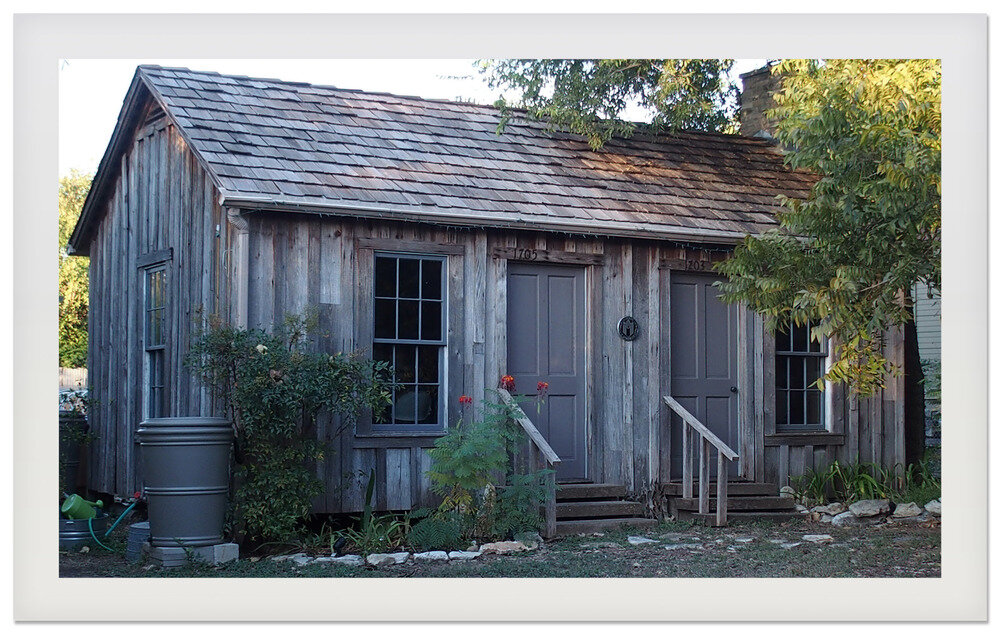Historic Undercurrents have Shaped Modern Clarksville
(The purpose of this blog post is to give a brief history of Austin’s historic Clarksville and share useful information to the Imagine Art/St. Luke project Touchstones & New Beginnings.)
Tudor style home on the edge of Clarksville, now a popular restaurant.
Strolling West Lynn Street between 6th and 12th, you find the street lined with businesses, chic dining spots, a 100-year-old elementary school and a house of worship. One senses the coziness and quaintness of this unique neighborhood, nearly hidden by a canopy of live oaks. Time-travel further west into a labyrinth of post-Civil War streets and houses—a mixture of “two room” and '“L-plan” homes, and what are called “shotgun” houses (so named because you could fire a shot from the back door through the front one without hitting a wall). The houses lend charm, character and history to the already vibrant community known as Clarksville.
Clarksville and Haskell House
Little communities formed. The first thing they would build was a church or a Freedman’s Bureau school.
Susan Pearl, historian at Prince George’s County Historical Society in Maryland.
Like many of the black settled communities after the Civil War, Clarksville centered around church and school. Visitors learn from historical plaques commemorating landmarks that Clarksville was one of the first Freedman communities (founded and settled by former slaves) in Austin. It’s also the oldest surviving Freedman community West of the Mississippi. Clarksville gets its name from Freedman, Charles Clark, who purchased two acres from a Confederate general, built his home then portioned out the rest to other Freedmen. His idea, and hope, was that these new neighbors would reunite with family and friends.
Before the Sweet Home Baptist Church was built, religious meetings would be held at the Haskell House. The Cumberland-style house is an example of Clarksville’s earliest architecture. Simple board and batten shacks such as this were built to provide the most basic shelter. A distinctive feature is its two front doors – a family could rent one of the front rooms for extra income. (from “A Short History and Historic Tour”, 1978 by John Henneberger)
The Clarksville historic district is bordered by West Lynn, W.10th Street, MoPac Expressway and Waterston. The community was inducted into the National Register of Historic Places in 1976 in recognition of its unique and valuable history. Take a walking tour of this famed neighborhood by clicking on this link. https://david-richards-s5ba.squarespace.com/s/Clarksville_WalkingTour-sm.pdf
The Church
Sweet Home Missionary Baptist Church stands as testament to the community’s struggles and perseverance. Originally built in 1871, the church has continued to be the heart and soul of Clarksville. The current church was built in 1935. Both church and community helped navigate encroachment threats from all sides and have, for the most part, managed to survive. They have endured the bulldozers, greedy speculators, City service cut-offs meant to isolate, Jim Crow laws of 1928, pressures to self-relocate to the “black district" in East Austin, the construction of MoPac (which displaced 1/4 of the population) and endless gentrification.
Because of discriminatory banking practices, the residents of Clarksville had to work hard and be resourceful to maintain and improve their homes. They proved to be an incredibly determined group of tightly knit folks who refused to leave their beloved church and neighborhood. They stood their ground against the all the hardships and injustices.
In 1978, the Clarksville Community Development Corporation was founded with the help of federal grants and loans. The CCDC built and obtained through donations a number of homes that it rented to low to moderate income families, and those who were displaced. This was the start of the organization's affordable housing program.
The Confederate Home
As fate would have it, The Texas Confederate Home for Men was built in 1884 and located adjacent to Clarksville. Before it was demolished in 1970, the home stood on 26 acres that extended as far south as 6th Street (part of it now an overgrown lot located near The Open Door child care center). The home's perimeter walls, its only recognizable remains, are still visible along W. 10th Street. How agitating it must have been for Clarksville residents to live next door to Confederate veterans! The home, whose residents numbered around 200 at its peak, was closed in 1965.
St. Luke
St. Luke United Methodist Church was granted its charter in 1938. As the community grew, they began holding services at the Texas Confederate Home for Men at W. 6th Street and West Lynn, next to Matthews Elementary School.
St. Luke is now located at 1306 W. Lynn where in 1958 the present Sanctuary was built. Many local talents contributed to that effort. A prominent feature is the beautiful, inspired wood carvings by Toni Silver.
Through its Community Outreach, St Luke has sponsored or is sponsoring many programs that benefit Austin's general population. These include the Hope Food Pantry, Senior Citizen Activity Centers, and Student Family Services, to name a few.
Enter Imagine Art
In February 2021, Imagine Art began leasing the classrooms vacated by St. Luke’s Pre-school located in back of the sanctuary. The organization is a Christian ministry established in 1996, serving the needs of artists with disabilities by offering high caliber art services. IA attracts non-disabled artists, too. The result is an inclusive, creative community.
Rick Hernandez, the AmeriCorps program director for Imagine Art, is spearheading the first art project between St. Luke and Imagine Art called Touchstones & New Beginnings. This first phase of the project will be the creation of three totems.
A totem is a spirit being, sacred object, or symbol that serves as an emblem of a group of people.
Each “peace pole” will commemorate the Clarksville neighborhood, its residents and the congregants of St. Luke. All these parties are invited to come and create a ceramic piece at one of three workshops: May 15th, 22nd, and 23rd from 1-4 p.m. They will be placed on the totems and unveiled on June 5th.
Even if you have never worked in clay, AmeriCorps Artists-in-Residence will be there to assist you in the creation of your work! When you have completed your part of the totem, they will take it to their ceramics facility to be fired. They will install the totems prior to the unveiling on June 5th. Participants will get to make a keepsake medallion as a memento of your participation. To learn more about this community art project, click below.
Please make plans to attend one of the workshops and through this art activity, share what living in this truly unique neighborhood means to you.
















